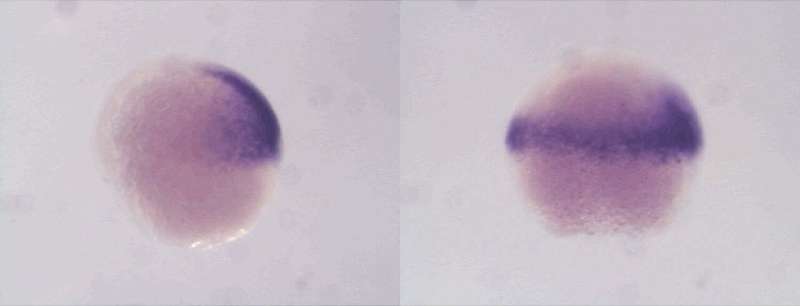How embryo cells gain independence

It happens in the first hours after fertilization: The cells of the early embryo begin to independently produce proteins, the building blocks for cells and organs. Their own, uniquely composed genetic material serves as the blueprint. In vertebrates, the starting signal for this process comes from three maternal proteins that bind to the DNA of the offspring. New findings from Dr. Meijiang Gao from a research team led by Dr. Daria Onichtchouk in the University of Freiburg's Institute of Biology I now show, using a zebrafish model, how two of these three start proteins of the egg cell elicit their roles and how they act in further development. The findings were published in a study in the journal Nature Communications.
"We have shown how the proteins Pou5f3 and Sox19b function at different time points in embryonic development and in different areas of the embryo," says the biologist of the study's integrative approach. She conducts her research at the University of Freiburg's Cluster of Excellence CIBSS—Centre for Integrative Biological Signalling Studies, whose scientists are pursuing the goal of understanding signaling processes across scales. Prof. Dr. Jens Timmer und Markus Rosenblatt from the University of Freiburg's Institute of Physics also participated in the study.
Important molecules for stem cell research
Similar human proteins, so-called homologues of Pou5f3 and Sox19b, are used in research to artificially produce stem cells from human skin cells. "The precise role of these factors in development is highly interesting for research and medicine for this reason as well," says Onichtchouk.
To determine precisely what genes are controlled in what way by these two proteins and how they interact, the biologist and her team studied the development of zebrafish embryos. They induced mutations in the genes for Pou5f3 and Sox19b so that the fish would no longer produce these regulatory proteins. In this way, they succeeded in demonstrating that the two proteins have independent tasks. However, they both act on the DNA by binding to gene regulatory regions and making the genes freely accessible to the cellular machinery.
Gene control in sleep mode
In addition, the team discovered that Pou5f3 and Sox19b suppress late genetic programs. "They keep important processes in sleep mode so that they do not start until later, when the appropriate step in development approaches," describes Onichtchouk. "This concerns the genes responsible for the development of the organs." However, Pou5f3 and Sox19b appear to be the determining factors for the activation of the genes only on the ventral side of the embryo. On the dorsal side, they are ineffective. Onichtchouk wants to determine the reason for this: "We are curious to find out what takes over this function here and whether these proteins also originate from the mother."
More information: Meijiang Gao et al, Pluripotency factors determine gene expression repertoire at zygotic genome activation, Nature Communications (2022). DOI: 10.1038/s41467-022-28434-1
Journal information: Nature Communications
Provided by University of Freiburg




















